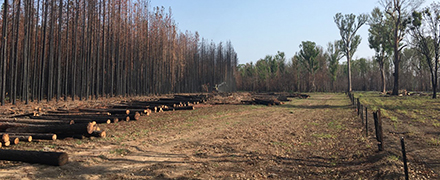
To paraphrase former US Secretary of Defence Donald Rumsfeld, the timber industry in Australia and New Zealand currently have some known knowns, and some unknown unknowns. To put it another way, the timber industry hopes it has a future, it just isn’t certain of what that future looks like. Source: Bruce Mitchell
In Australia, early estimates are that contractors have lost up to $15 million in revenue from the fires which burned through state forests and plantations over summer, with more than 40 pieces of equipment valued at $27 million damaged or lost.
With 50,000 hectares of pine plantation is fire impacted in NSW alone, Hyne Timber CEO Jon Kleinschmidt conceded the salvageability time frames remain unknown. What was known was that full recovery will take many years.
Victorian contractors in East Gippsland are also facing a “perfect storm” of crises, following the Andrews government’s announcement in November to phase out the native forestry timber industry by 2030.
And New Zealand recently had one of its largest wildfires in the last 20 years. Located in the high country, near Dunedin, it burned over 5000 hectares of remote bush, but without minimal damage to assets, it drew minimal attention.
On top of that the coronavirus outbreak has reportedly forced more than 1000 New Zealand forestry workers out of a job, as China closes its borders to deal with the crisis, and around 30% of the country’s logging crews are unable to work as they feel the crunch of supply chain disruption with sawmills closing down at an alarming rate.
Of course, much if not all, of this is out of everyone’s control. It was impossible to prepare for beforehand, and difficult to plan for in the aftermath. Or was it?
On the fire front, for a start, there are the startling revelations that in Victoria – for example – the State Government allocated $121.6m for forest furl management in 2018-19. But only $18.5m was spent on direct fuel management.
It can be argued that if more had been done the impact would have perhaps been mitigated. Who knows? We’ll probably never find out unless a thorough, very thorough, Royal Commission can get to the bottom of it all.
And New Zealand is not alone in putting so many of its eggs in the Chinese economic basket. Australia is also feeling the effect of having so much invested in a healthy Chinese economy which at present is in coronavirus lock-down.
There are, however, many positive signs.
In East Gippsland, there is some good news today with around 100 loggers who returned from fighting fires to be told they no longer have a timber job by VicForests being re-employed to help clear highways and roads so that the industry can get back to business.
It will be slow work, but it will be work with the prospect of life getting almost back to normal for a while.
And the Timberlink Board has approved plans to enter the growing mass timber market enabled through building a state-of-the-art Cross Laminated Timber (CLT) and Glue Laminated Timber (GLT) manufacturing facility in Victoria or South Australia that will service this growing market segment.
Victoria is an obvious choice for the facility, because that’s where the market it; the Green Triangle is an obvious choice because that’s where the timber is, and where Timberlink’s multi-million dollar Tarpeena mill facility is. In either case Timberlink faces transporting large amount of timber in some form across Victoria.
It is to be hoped – and it is Timberlink’s stated hope – that it does not become an exercise whereby the respective state governments engage in a bidding war.
But it does show that the industry sees a future, and a very bright future at that. Engineered wood is the future for the building industry world-wide and we must become as self-reliant as possible as soon as possible.
France, for example, is set to require that all new public buildings must be made at least 50% from wood or other sustainable materials from 2022 as it pushes for sustainable urban development.
Canada is also joining the march towards increased use of CLT in multi-story buildings.
They won’t be alone.





